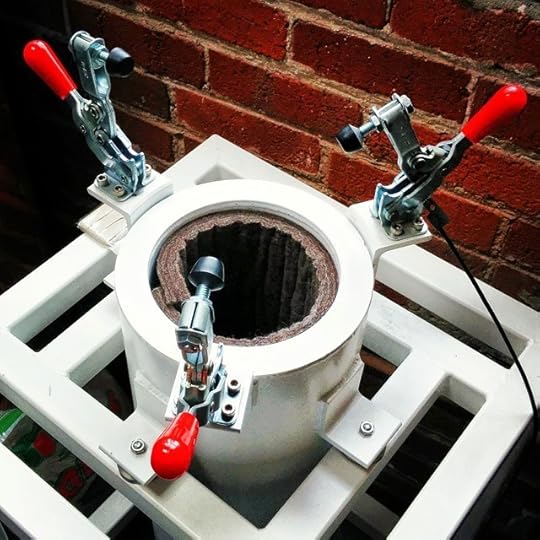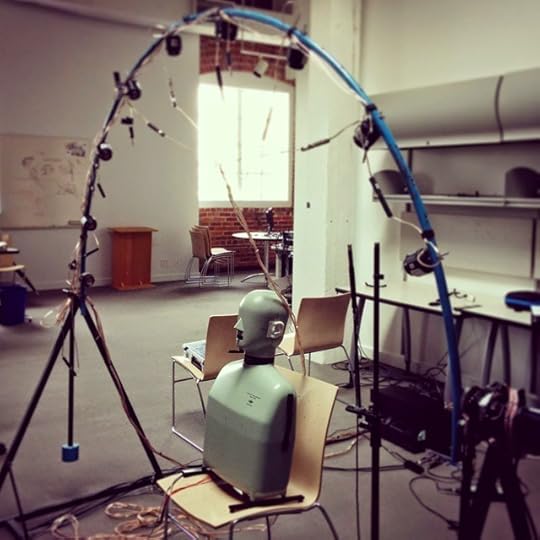Marc Weidenbaum's Blog, page 398
December 13, 2014
via instagram.com/dsqt
December 12, 2014
“Silent Night,” Noise Edition
There is something inherently electronic about the holidays. The most glitched-out, gentle static sounds like the distant hum of a wandering band of carolers, like the whir of electricity demanded by a block of houses full of lit-up trees, like a year expending its last bit of energy before being wound back up for the next dozen months. This is the sound of “silent-silent.night” by Forelight, the halo of the holidays, the first half of its 12 minutes a haze of digital glisten, followed by a short sequence of what seems to be modified everyday sound, all carillon and traffic, followed by an extended, reverberant reworking of the classic carol from which the piece takes its name.
Track originally posted at soundcloud.com/forelight.
via instagram.com/dsqt

Another sound-lab shot. Small “noise bomb” chamber for testing microphones in near-silence.
Cross-posted from instagram.com/dsqt.
December 11, 2014
Disquiet Junto Project 0154: Groove Unlocked

Each Thursday in the Disquiet Junto group on SoundCloud.com and at Disquiet.com, a new compositional challenge is set before the group’s members, who then have just over four days to upload a track in response to the assignment. Membership in the Junto is open: just join and participate.
This assignment was made in the evening, California time, on Thursday, December 11, with 11:59pm on the following Monday, December 15, 2014, as the deadline.
These are the instructions that went out to the group’s email list (at tinyletter.com/disquiet-junto):
Disquiet Junto Project 0154: Groove Unlocked
The Assignment: Create a track from two locked grooves.
This week’s Disquiet Junto project builds on last week’s. Last week, 67 different musicians uploaded as many locked grooves. This week we’ll make new music atop the locked grooves. Here are the steps. Note that there are some options:
Step 1: Choose two locked grooves from the set at http://goo.gl/0s4WmM. You can accomplish this in several ways. You can choose random numbers between 1 and 67 and use those tracks, or you can just select the tracks you most want to work with. Note that most of the tracks should be set to allow, via Creative Commons, for non-commercial re-use. However, if you aren’t sure, please contact the musician to confirm.
Step 2: Make a new track alternating the two locked grooves for between one and two minutes.
Step 3: Use the track that resulted from step 2 as the foundation for a new piece of music. Transform it as you desire, which might include altering the foundational track and adding new material atop it.
Step 4: Upload the finished track to the Disquiet Junto group on SoundCloud.
Step 5: Listen to and comment on tracks uploaded by your fellow Disquiet Junto participants.
Length: Your finished work should be between roughly 1 and 2 minutes long.
Deadline: This assignment was made in the evening, California time, on Thursday, December 11, with 11:59pm on the following Monday, December 15, 2014, as the deadline.
Upload: Please when posting your track on SoundCloud, only upload one track for this assignment, and include a description of your process in planning, composing, and recording it. This description is an essential element of the communicative process inherent in the Disquiet Junto.
Title/Tag: When adding your track to the Disquiet Junto group on Soundcloud.com, please include the term “disquiet0154-grooveunlocked” in the title of your track, and as a tag for your track.
Download: It is preferable that your track is set as downloadable, and that it allows for attributed remixing (i.e., a Creative Commons license permitting non-commercial sharing with attribution).
Linking: When posting the track, please be sure to include this information:
More on this 154th Disquiet Junto project — “Create a track from two locked grooves” — at:
http://disquiet.com/2014/12/11/disqui...
More on the Disquiet Junto at:
Join the Disquiet Junto at:
http://soundcloud.com/groups/disquiet...
Disquiet Junto general discussion takes place at:
Image associated with this project by Risa:
via instagram.com/dsqt

Head and torso simulator from yesterday’s audio-lab tour. #soundstudies
Cross-posted from instagram.com/dsqt.
December 10, 2014
Madeleine Cocolas & Monolyth & Cobalt, Monthly
Madeleine Cocolas — born in Australia, based in Seattle — has begun a new monthly music series, each track of which is a collaboration with Monolyth & Cobalt. There are two tracks in their effort so far. The series follows Cocolas’ previous “Fifty-Two Weeks” project (see madeleinecocolas.blogspot.com), which took longer than one full year for her to complete, but during which she managed all manner of musical exercises. Like the most memorable of the Fifty-Two Weeks music, the first track in her new series with Monolyth & Cobalt achieves a natural, patient balance between classical ambient music and, well, actual classical music, of the chamber variety. Lens-flare synthesis finds its match in elegant, patiently revealed arrangements for more “traditional” instrumentation. The second track opens with a texture that seems alien to the first one, the rough sound of dirt, of gravel, of vinyl surface noise. That sound, which suggests slow toil and a state of disrepair, underlies an angelic vocal line, amid soft, lightly transformed touches of piano, until closing with a horn like that of a forlorn lighthouse.
Month one:
Month two:
Both tracks originally posted at soundcloud.com/madeleine-cocolas. More from Cocolas at madeleinecocolas.com, and more from Monolyth & Cobalt, aka the French composer Mathias Van Eecloo, at soundcloud.com/monolyth-and-cobalt and monolythcobalt.com.
via instagram.com/dsqt

Shot of anechoic chamber I took my sound-course students to visit today. #soundstudies
Cross-posted from instagram.com/dsqt.
December 9, 2014
This Week in Sound: Hawking, Antarctica, Automobiles, Screams
When I first started to plot bringing back the Disquiet.com email newsletter, I almost turned it entirely into this one sub-section, This Week in Sound, which I imagine to be a possibly intriguing, maybe even useful, memo about various aspects of the role of sound in the media landscape. In the end I decided This Week in Sound would be core to the newsletter, but still just one part of it, mixed in with short essays, lists of things worth listening to — all the other stuff that’s been in the newsletter since it reappeared in your inbox last month. Well, if you were already a subscriber — there have been many new subscribers since re-launch, and thanks for your attention, very much.
Text-to-Speech Supervillain: The big news about Stephen Hawking this past week was his stated desire to play a supervillain in the next James Bond film, but the more engaging Hawking news was his work with the developers of the software SwiftKey “to write and speak with greater ease for longer periods and minimise typos.” It’s especially fascinating that the muscle Hawking uses to control his communication is in his cheek: even when he is transmitting text, it’s centered in a part of the body associated with speech.
http://swiftkey.com/en/blog/swiftkey-reveals-role-professor-stephen-hawkings-communication-system/
Radio Free Antarctica: Michelle Fournet, a PhD candidate in acoustics, has been aboard a Korean ice breaker headed to Antarctica to recover an ocean-bottom hydrophone. As she explains, “The seemingly impossible recovery task is accomplished by chirping. We’ll be using something called an acoustic release. What that means is I have a piece of equipment on the deck of the ship with an acoustic element that gets slung overboard to ‘chirp’ into the water. The right chirp, at the right frequency, and the right timing, will wake up an element built into the hydrophone on the ocean bottom. If it hears the right signal, it chirps back a predictable reply.” Better yet, she is blogging the entire journey and mission. As of this morning she had arrived at Jang Bogo Research Station in Terra Nova Bay. http://blogs.oregonstate.edu/bioacoustics/2014/12/09/antarctica-part-iv-continent/
Luxury Lofts Killed the Recording Studio of the Stars: The London studio where Brian Eno’s Another Green World, Led Zeppelin IV, and Queen’s “We Are the Champions” were recorded is being shut down to make way for fancy apartments. The studio was founded in 1969 by Island’s Chris Blackwell and has since 1982 been owned by producer-musician Trevor Horn (The Buggles, Yes, Art of Noise). Between Eno and Horn alone, that’s a place closely associated with the role of the recording studio as an instrument unto itself. While luxury flats are certainly the immediate cause of the studio’s end, the broader cultural scenario, in which home recording has supplanted and financially undermined the major-league studios, is one that owes a debt to folks like Eno and Horn in the first place. (Thanks to Geeta Dayal for the Another Green World reference.)
http://www.aljazeera.com/indepth/features/2014/12/silence-falls-london-recording-studios-201412467831715.html
Sound and Automobile Design: It was one thing when the BMW-sponsored section of Medium happened to include a detailed, car-related story in the form of Nate Berg’s explanation of how roadside barriers function to make highways and freeways quieter. It was another when BMW itself got a byline for a story about how door sounds are fine-tuned (interesting note: “consumers subconsciously tend to interpret imbalance as structural weakness, not protective strength”). Either way, I’ll be using both articles in the sound course I teach.
https://medium.com/re-form/muting-the-freeway-e18ee195bd38
https://medium.com/re-form/click-clack-clunk-how-the-perfect-car-door-sound-is-made-and-why-it-matters-2cf867983a34
Scream Team: The National Film Board of Canada, the NFB, has produced a celebration of screaming called, naturally, Primal. It’s an open Internet collaboration in which people are invited to, well, scream. It reads, in part, “Go ahead. Liberate yourself. Give it all you’ve got.” It’s a more immediate, visual, active, immediate rendering of what Hans Zimmer was up to several years ago when he crowd-sourced chants for The Dark Knight Rises. The NFP project was co-produced with Encuentro, the TV station of Argentina’s Ministry of Education.
http://primal.nfb.ca/en/about
SoundCloud InterfaceSpotting: Last week I mentioned that SoundCloud had added single-track repeat to its service, and this week I noticed that shuffle play has also joined the product offering.
http://disquiet.com/2014/12/08/soundcloud-introduces-shuffle-play/
This first appeared in the December 9, 2014, edition of the free Disquiet email newsletter: tinyletter.com/disquiet. Unfortunately, the publication was held up for some reason by TinyLetter’s “abuse prevention system.” I didn’t even curse.
Brian Eno Mid-1990s Mega-Mix
Perhaps I’m mistaken, but I don’t think I’m going out on a limb when I say that the Brian Eno albums Nerve Net, The Shutov Assembly, Neroli, and The Drop are not on a lot of people’s lists of their favorite works by him. The records came out as a fairly steady series beginning in 1992, after an extended break from solo studio work. His previous album to 1992’s Nerve Net was 1985’s Thursday Afternoon, a personal favorite, but a lot happened in the intervening years. In any case, those four records have all been made available as bonus-track-laden reissues by All Saints, and if they in initial form struck your ear as more a collection of interesting individual ideas than standalone listens, then perhaps this track by Clark is what you’ve been waiting for. It’s a mix of highlights from the eight discs that comprise the reissue program, 34 minutes in all:
Track originally posted for free download at soundcloud.com/all-saints-records. More on the reissues at allsaintsrecords.com. The reissue remix also serves as a promotion for Clark’s new self-titled album, which Warp released last monght. More from Clark at throttleclark.com.
December 8, 2014
SoundCloud Introduces Shuffle Play

Another welcome addition to the SoundCloud interface: shuffle play. Just last week I noted the appearance of the ability to repeat a single track. At least since the Instagr/am/bient compilation album was posted back in late 2011, I have hoped for a shuffle option on SoundCloud sets. The Instagr/am/bient album, by way of example, has 25 tracks by 25 different musicians, and the first track, “Up Above the Hill-Sky” by Marcus Fischer, has as of this writing 9,412 listens, while Christopher Olson’s “Swanoji” hovers well under 1,000, at 633. While Fischer’s track’s popularity is well-deserved, overall it’s clear that the declining rate of listening corresponds almost directly with track placement. The only serious exception is the OO-Ray’s “Silhouettes,” which has 3,714 listens, compared with 1,974 for the track after it and 1,063 for the track preceding it.
In any case, shuffle play, along with the single-track repeat, is a welcome addition. We’re making use of the single-track option in this week’s Disquiet Junto project, which explores the notion of locked grooves, or the practice back in the days of vinyl of having a short single-revolution loop that repeats. The shuffle play will make the resulting set, along with all other SoundCloud sets, all the more enjoyable for listeners to explore.

Neither of these two tools seems to have yet been introduced to the embedded player, or the mobile app, but it seems likely that’s down the road.




